Knee High By the Fourth of July
New views of corn…
***
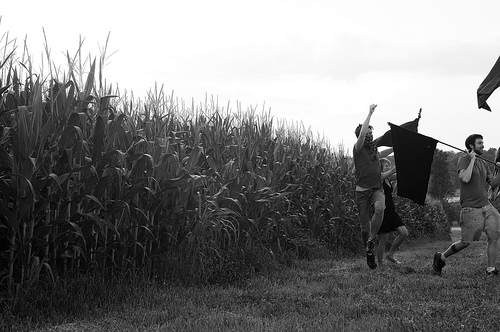
***
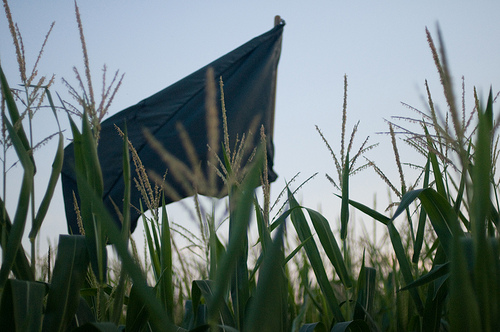
***
So let the rain become a raging flood
To wash away buildings and boundaries
Swallow whole the world we have known
And as the waters rise
Let the black flag fly
A Revived Farming Life Blog
New views of corn…
***

***

***
So let the rain become a raging flood
To wash away buildings and boundaries
Swallow whole the world we have known
And as the waters rise
Let the black flag fly
Capitalism is dead to me. I would like to see its stinking carcass burned and buried, preferably someplace where no archeologist could ever attempt an excavation, some cavern on the edge of town guarded by the ghosts of slaves, undead Wobblies and a statue of Mother Jones that shoots fire from its eyes.
Yeah, capitalism is dead to me, but mine is a minority opinion. I’ll dance on that grave someday, and my own grave too, thank you. But what happens when people decide that a symbolic gesture is in order, a mock procession of ecstatic mourners cheering the burning hulk of centuries of mistreatment? What happens when a funeral for capitalism gets disrupted by folks who simply don’t want to believe it is dead?
To back up, in late November Kristin and I were planning to go to a street party in Chapel Hill to celebrate the death of capitalism. The plan was to have a funeral in the street and then dance in the same street. But that night was cold, so we decided to stay home, stoke the wood stove and get under the blankets. We figured the industrialists, et al wouldn’t miss us at graveside.
Many other folks thought it too cold for a funeral as well, but eventually enough people showed up to actually make the party go on. The cops didn’t like the idea, started shoving and pressing and yelling and spraying and doing all the things that annoy all the people like me who have any sense of the rights and responsibilities of anti-authoritarian living. Just try to get your dancing condoned in the streets of Chapel Hill!
Police Chief Brian Curran said his officers dealt with the situation appropriately. He said police do not condone dancing in the street and had not issued a permit for the protest.

As the clash went on, several un-arrests were made, but one person was taken to jail. It is that one person that brought about the need for another party.
Nick Shepard, 24, the manager at International (sic) Books on Franklin Street, was the only person arrested. He was charged with assaulting an officer.
This is where the story pretty much starts for me. I love knowing that if I were in a similar situation, a hundred people have my back even if they don’t know me very well or know me at all.
Friday night Kristin and I went into Carrboro for a benefit event billed as “Punk ‘N Pie”, a date auction where the winner of the pie gets a blind date of their choice with the pie baker. After the auction would be a re-enactment of the defeat of the police using puppets, then a smashing of a capitalism pinata and finally a bunch of bands.
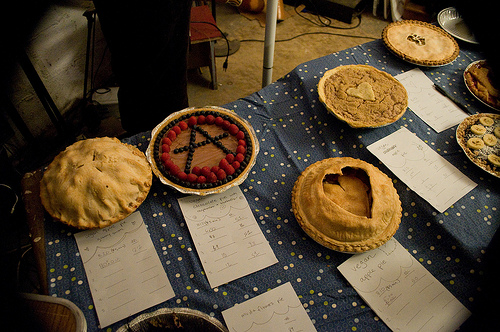
Yeah, we made a pie – a chunky, buttery, local sweet potato pie made with Carolina Ruby sweet potatoes, local honey, local eggs and sweet cream butter from Homeland Creamery. No, it wasn’t a vegan pie, but I wanted it to be different and supportive of local farmers. Local fat is hard to come by unless it is from a creature.
There were a dozen or so other pies on the table when we got there, many with multiple bids on them. There was the dumpstered pie with the added slogan “Let’s Paint the White House Black” with a black flag decorated on the side.
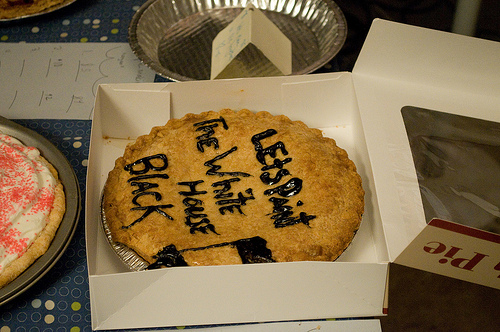
There was the giant apple pie with a heart cut out…

…a vegan pot pie and several cookie pies.
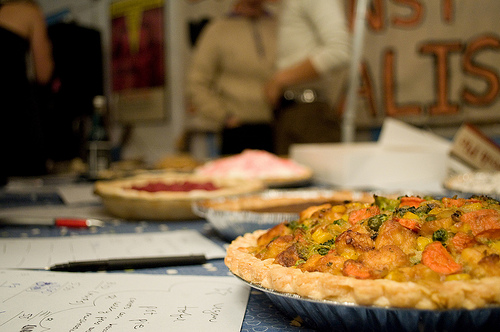
Then there was the “Let’s Make a Pie Together” date pie…
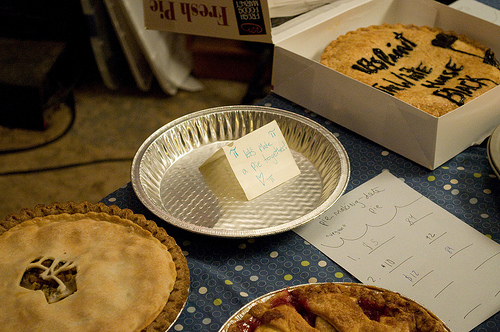
…and a Mud and Flowers pie that was really a pie pan filled with mud, leaves, sticks and flowers.
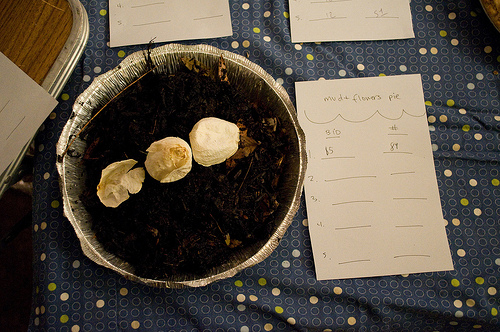
The auction raised several hundred dollars for a legal defense fund for Nick.
Kristin won our pie despite some other pretty high bids. So I got that date going for me.
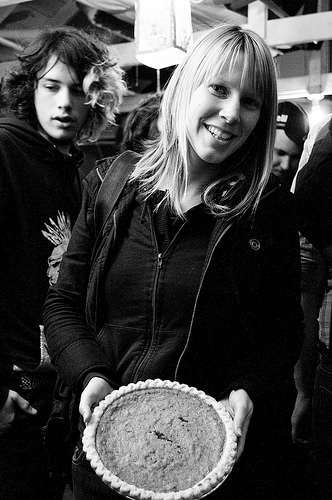
More to come…
you give me way too much credit for making that pie. all i did was pester you as i was blowing my runny nose while lounging in bed. the least i could do was win a date with you.
I am reading Secrets of the Soil as of right now, it is a very eye opening book. Ive had alot of time this week to read it so i have come pretty far, so hopefully the knowledge will be fully planted by this weekend. Yes certainly, i would enjoy any books that you could suggest for me.
Mmmm…dirt pie!
delia loves the circleA pie with raspberries…she would have bid on that one!
…i miss delia…
It is hard to shake the stigmas and myths surrounding the word anarchist. We are the only political and social subculture deemed to be “self described” as if we are so disorganized that it is deemed to be a miracle that we could describe ourselves in the first place. We are perpetually filed away as unimaginative or self-absorbed or dismissive of others’ ideas if they are not “chaotic” enough. That’s crap.
For the record, most of the anarchists I know are brilliant and strong organizers. Their strategies for building a community that leaves the individual intact but creates a greater whole are unparalleled. They give without leaving their name, and that is perhaps the biggest problem. When anarchists shun the praise for their ideas and actions, the world is left to wonder about what it is that we do and why our ideology is so much more relevant than any of the self serving garbage that seems to always be on display.
For the first Pittsboro Pecha Kucha night – a series of presentations featuring twenty slides with twenty seconds to speak during each slide – I decided to discuss what to me is an idea that makes perfect sense. Franchise anarchism, the spreading of non-hierarchical organization, is something that a few others have spoken about in passing. I have found sparse references to it in the ether, and the general idea is the same – spread the idea without taking ownership globally.
Maybe I should just let the presentation speak for itself…
Slide 1: “Franchise Anarchism” is a pretty simple idea. Communities, like weeds, can and will organize themselves more efficiently and more successfully outside the help of government, big non-profit and multinationals. An idea can spread and be successful in any part of the world without rules handed down from an overarching hierarchy.
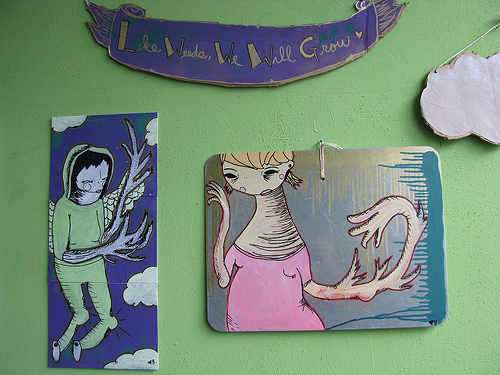
Slide 2: Our leaders are lost out there; they don’t have the time, capacity or desire to understand the needs of every citizen they claim to represent, those needs can easily be understood by a neighbor or another community member. While politicians write the laws that run our lives, coming to visit us only when it is politically necessary,
Slide 3: to cut a ribbon or have a fundraising dinner, we are here searching for ways to get out of the loneliness and vapidity of the television, to cut through the lies and build a real community that responds directly to our needs and we to its needs.
Slide 4: Our differences are on display daily, from what we drive to what we eat. but in order for the community to function we can’t be labeled as bicycle hippies or SUV driving jerks. We have to realize that we have common enemies as well as common friends.
Slide 5: Miami, 2003, the site of the latest Free Trade Area of the Americas negotiating talks, the FTAA being the state’s version of free trade, which is never free. Miami, 2003, up to that point the single largest militarization of the domestic police force in United States history.
Slide 6: The power of the state is not benign, looking out for the little guy, the middle class, the “hard workers”. The power of the state is manifest concretely in the military weapons it provides its police, the silence encountered when a police officer was asked for their badge number or to “please, lower your weapon – I am simply searching for my right to assemble.”
Slide 7: The realization that I had in Miami – after seeing the bloodied faces of journalists, the welts forming on the backs of those trying to escape the concussion grenades, was that our place in organizing as anarchists had to occur in other venues besides the street. We had to engage our community and do it in a way that released all the political ideology to the wind. The Really Really Free Market was born in Miami in 2003.
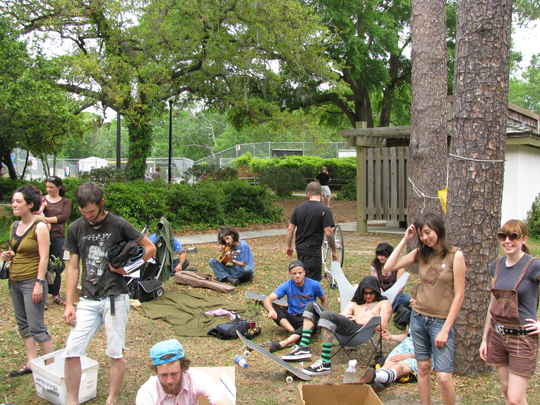
Slide 8: The RRFM is the newest iteration of franchise anarchism. The idea is simple – bring what you don’t need and take what you do. No money, no advertising, no bartering, no trading. No swap meets, no charity events, no ticket booths, no entrance fee. Put simply, everything is free.
Slide 9: The RRFM builds community by directly engaging its individual pieces through the word that everyone loves – free. There is nothing too small to offer, nothing turned away. Music, haircuts, juggling lessons, recipes, plants, seeds, bike repair, puppet shows…
Slide 10: The idea of the RRFM is built on several concepts that had come and gone in the activist underground for decades. The Diggers in San Franscico pioneered the idea, forming a community whose purpose was to give away the waste and the excess of the system. Then came free stores, guerrilla gardening, Critical Mass bicycle rides…
Slide 11: It is a way to reach children, show them the value of interacting with all types of people, teach them a new skill or send them home with something they may not have had access to otherwise whether it is an idea or a piece of clothing.
Slide 12: Free markets are great ways to distribute clothing, shoes, infant products to underserved or homeless individuals, thrifty parents, not-so-thrifty parents, students, elderly on fixed incomes… Bringing a large cross section of socio-economic classes together serves to build the framework in which the community in the free market space can see through differences and focus on common goals.
Slide 13: Another aspect of free markets in the idea of self-sufficiency especially in the realm of food security. Seed saving skill shares and free plants create a situation where a small component of an individuals food needs may be offset by their own work.
Slide 14: RRFMs since 2003 have spread to dozens of cities around the country with some of the most popular and longest running in North Carolina. Greenville, Raleigh, Carrboro, Greensboro, Wilmington, Boone and Asheville have thriving markets and community continues to build around them.
Slide 15: Offshoots of free markets often occur in the form of food banks, skill share workshops, bike repair programs and the like which occur outside of the free market hours.
Slide 16: A large component of the RRFM is Food Not Bombs, perhaps one of the best known and most popular examples of franchise anarchism in the world. Starting from one location in the 1980s, Food Not Bombs now has hundreds if not thousands of events worldwide.
Slide 17: The idea is very simple – cook free food recovered from the waste stream and serve it to the hungry. The organizational concept is easy to fit wherever there is food waste and hungry people., which, by the way, is everywhere.
Slide 18: The Really Really Free Market concept, in my mind, is a way to use what has worked from the old models and appropriate those things to build a solid franchise. The basis for are the tenets of anarchism: community based, non-hierarchical, inclusive, effective, non-governmental, do-it-yourself, consensus-based, and sustainable.
Slide 19: All of that is great, but resistance to building the kind of community where nothing is for sale can be a bit strong. Food Not Bombs is frequently shut down using laws that prohibit the sale of food without a permit. Police and politicians are unfamiliar with the idea of “free” anything and thus are a huge obstacle in the creation free flowing, non-permitted community activities.
Slide 20: We are replacing a culture where neighbors are feared, We are replacing a culture where industry treats communities like dumps, We are replacing a culture where children play in the diseased clay of bad decisions, We are replacing a culture that says representative democracy is good enough, We are replacing a culture…
Originally named “End of the Line”, Local Revolt (the linked interview and its out-of-context editing and framing used to make me really angry, now it is just funny and reads like bad satire) was a short lived anarchist house. After three years, its vision of becoming a collective never really materialized although we often called ourselves a collective. Plenty of folks came and went…bands played, art shows were held, films were screened, books were loaned, protests were planned, shit was talked. I was the only person to stay there from start to finish, living in each of the three bedrooms at some point along the way. I may have been the only person that actually loved that house, but even I knew when it was time for it to come to an end.
We had a Free Store that was abused by anyone who wanted to come and dump their junk on us. We had an open door policy that allowed a homeless prophet to move in for a month and eat all our food and watch free cable all day in the basement. We had a lax housemate policy that brought in some sketchy folks who had to be kicked out after very short stays.
We had loud housemates, housemates who wanted to run us into the ground with their window AC units, housemates that would never come out of their room. In total there were fourteen people who revolved through the bedrooms. In addition there were dozens of travelers. I am still in contact with a few of those traveler folks, and most were great to hang out with. Whether they had hitchhiked or hopped a train into town for something to do or were biking the East Coast or walking from the West Coast and back, everyone had a story that stuck with me.
Anyway, this is supposed to be a post about a garden…
I started a garden even before I officially moved into the house. I slept on couch cushions on the floor in my room, but didn’t care as long as I got some beans and tomatoes and squash and flowers in the ground as soon as possible. The area of the garden was pretty shady, so I had to get creative with its placement.
One of the first things to go in were the compost bins. The next was a driveway garden.
The bins are in the back right of the picture. The driveway garden usually had the greens, lettuce and a smattering of sunflowers. I grew edible nasturtiums and cosmos as well.
After the first year the gardens got a little bigger. I was able to clear some vines and small trees from a fence area in order to get more light and focus on the backyard garden. Cherry tomatoes, beans, greens and summer squash all did pretty well there. Basil and rosemary also did well, but other herbs didn’t really take.
The garden was often a happy mess of a place. The garden gate was the aluminum decoration from an old screen door. Office filing shelves served as compost sifters. Metal shelving supports from the Office Depot dumpster made up the bean trellis. Notice the assorted chairs rescued from the garbage as well as the gaggle of duck decoys on the porch railing. The porch itself was a disaster. One of the old housemates briefly tied his dog to one of the columns. The dog ripped the column out, breaking part of the flashing that attached to the house thereby setting up the roof to leak for the next two years.
We moved out during the summer when tomatoes and squash were coming off. I was pretty depressed about leaving, so I left a lot of the stuff unharvested. The garden was tilled under soon after I left and is probably a nice, green, chemically altered lawn at this point…
I’ll break the suspense on this thread of past gardens; none of the three in this series are still around.
Is it just me, or does the linked Lo’Rev’ article end abruptly?
It is a technical error, or just bad writing?
Horrible writing and just an all around bad interview. The worst…
July 30, 2009 at 10:25 am
Great From the Depths reference. They are good friends of mine. Nice to see it on this blog.
August 11, 2009 at 11:05 am
The pictures were from a video shoot for the “Let the Black Flag Fly” song. I’ll post it whenever it comes out…